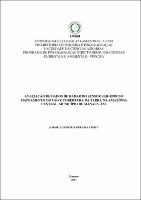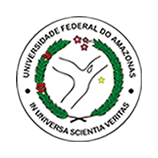| ???jsp.display-item.social.title??? |


|
Please use this identifier to cite or link to this item:
https://tede.ufam.edu.br/handle/tede/4514| ???metadata.dc.type???: | Dissertação |
| Title: | Avaliação de dados de radar do sensor SAR-R99B no mapeamento do uso e cobertura da terra na Amazônia Central, município de Manaus, AM |
| ???metadata.dc.creator???: | Costa, Jorge Alberto Lopes da  |
| ???metadata.dc.contributor.advisor1???: | Costa, Lizit Alencar da |
| ???metadata.dc.description.resumo???: | Nas últimas décadas as áreas de floresta tropical na região Amazônica têm sido fortemente impactada por um rápido processo de conversão da cobertura vegetal em outros tipos de uso devido à ação antrópica. No contexto das mudanças globais, os mapeamentos e monitoramentos de uso e cobertura da terra fornecem subsídios para as análises e avaliações dos impactos ambientas em virtude de acelerados processos de mudança na paisagem. Neste contexto, este estudo avaliou o potencial dos dados de radar de abertura sintética para discriminação de uso e cobertura da terra na região de Manaus, estado do Amazonas. Foi utilizada uma imagem multipolarizada do sensor aerotransportado SAR-R99B (banda L), com 3 metros de resolução espacial. Realizaram-se classificações na imagem radar sem filtro e com filtro Gamma 3x3. Avaliou-se o classificador pontual MAXVER-ICM e o SVM (Support Vector Machine), onde em todos os casos utilizou-se das imagens multipolarizadas em amplitude individualmente (HH, HV e VV), aos pares (HH e HV), (HV e VV) e (HH e VV) e em conjunto (HH, HV e VV). Os resultados obtidos foram comparados utilizando-se como parâmetro o coeficiente de concordância Kappa. O classificador SVM apresentou acurácia superior em relação ao classificador MAXVER-ICM. As melhores classificações foram obtidas para a polarização dual HH e VV com o classificador MAXVER-ICM e (HH, HV e VV) com o classificador SVM ambos utilizando as imagens com filtro. A acurácia mais elevada foi para a classificação com SVM e imagens com filtro (kappa = 0,7736). Analisou-se a influência do uso de filtro GAMMA no desempenho dos classificadores onde se contatou que as imagens filtradas proporcionaram um incremento nos resultados, em média, na ordem de 8%. Deste modo realizou-se a análise dos resultados das classificações, onde se constatou que o melhor resultado foi proporcionado pelo conjunto de dados multipolarizados (HH, HV e VV)classificados através do método SVM. Assim, concluiu-se que o uso de imagens de radar no mapeamento de classes temáticas de uso e cobertura da terra, em regiões tropicais, pode ser considerado como uma proposta viável. |
| Abstract: | In recent decades the areas of rainforest in the Amazon region has been heavily impacted by a rapid process of conversion of vegetation cover in other types of use due to human action. In the context of global change, the use of mapping and monitoring land cover and provide information for the analysis and evaluation of environmental impacts due to accelerated changes in the landscape. Therefore, this study evaluated the potential of data from synthetic aperture radar for discriminating use and land cover in the region of Manaus, Amazonas state. We used a multipolarized image from sensor airborne SAR-R99B (L band), with 3 m spatial resolution. Were evaluated the MAXVER-ICM and SVM (Support Vector Machine) classifiers, where in all cases we used the images individually multipolarized amplitude (HH, HV and VV), in pairs (HH and HV), (HV and VV) and (HH and VV) and together (HH, HV and VV). The results were compared using as parameter the Kappa coefficient. The SVM classifier had higher accuracy compared to MAXVER-ICM classifier. The best classifications were obtained for the dual polarization (HH and VV) with MARVER-ICM classifier and (HH, HV and VV) with the SVM classifier both using the images with the filter. The accuracy was highest with SVM for classification and filter images (kappa = 0.7736). Were analyzed the influence of using GAMMA filter performance on the classifiers where it showed that filtered images have provided an increase in the results, on average, about 8%. Thus there was the analysis of the classification results, which found that the best result was provided by the dataset multipolarized (HH, HV and VV) classified by the SVM method. Thus, we concluded that the use of radar imagery in mapping thematic classes use and land cover in tropical regions, can be considered as a viable proposal. |
| Keywords: | Uso e cobertura da terra Sensoriamento remoto Mapeamento geológico SAR-R99B Processamento digital de imagens MAXVER-ICM Land use land cover Remote sensing Synthetic aperture radar Support vector machine |
| ???metadata.dc.subject.cnpq???: | CIÊNCIAS AGRÁRIAS: AGRONOMIA: RECURSOS FLORESTAIS E ENGENHARIA FLORESTAL |
| Language: | por |
| ???metadata.dc.publisher.country???: | Brasil |
| Publisher: | Universidade Federal do Amazonas |
| ???metadata.dc.publisher.initials???: | UFAM |
| ???metadata.dc.publisher.department???: | Faculdade de Ciências Agrárias |
| ???metadata.dc.publisher.program???: | Programa de Pós-graduação em Ciências Florestais e Ambientais |
| Citation: | COSTA, Jorge Alberto Lopes da. Avaliação de dados de radar do sensor SAR-R99B no mapeamento do uso e cobertura da terra na Amazônia Central, município de Manaus, AM. 2011. 115 f. Dissertação (Mestrado em Ciências Florestais e Ambientais) - Universidade Federal do Amazonas, Manaus, 2011. |
| ???metadata.dc.rights???: | Acesso Aberto |
| URI: | http://tede.ufam.edu.br/handle/tede/4514 |
| Issue Date: | 7-Jul-2011 |
| Appears in Collections: | Mestrado em Ciências Florestais e Ambientais |
Files in This Item:
| File | Description | Size | Format | |
|---|---|---|---|---|
| Dissertação - Jorge Alberto Lopes da Costa.pdf | Dissertação - Jorge Alberto Lopes da Costa | 11.97 MB | Adobe PDF |  Download/Open Preview |
Items in DSpace are protected by copyright, with all rights reserved, unless otherwise indicated.




